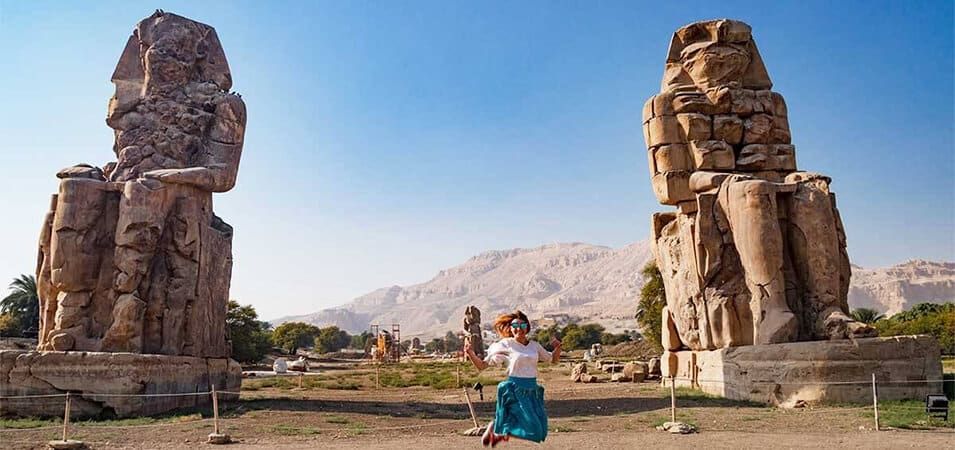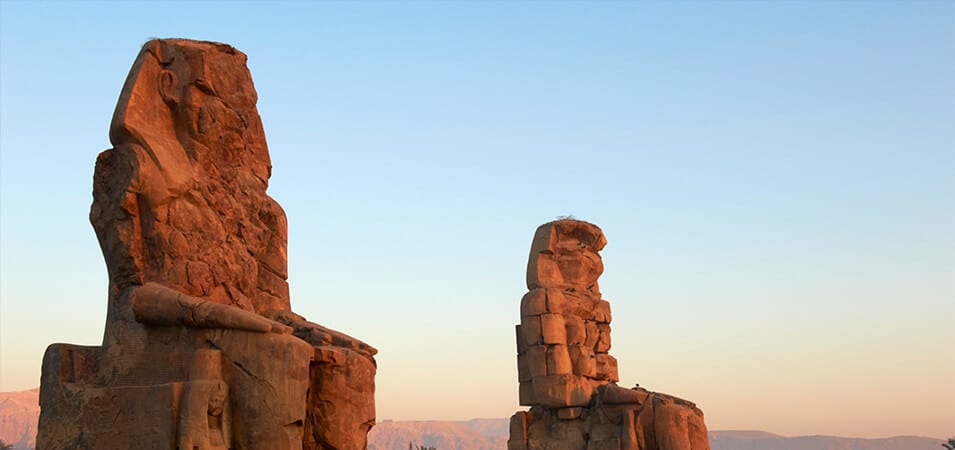Welcome to the fantastic world of the Colossi of Memnon in Luxor! The Colossi of Memnon is a famous historical site on the west bank of the Nile River in Luxor, Egypt. It has drawn people from all over the world. These two vast statues of Pharaoh Amenhotep III have stood proudly for thousands of years, watching time go by and empires rise and fall. In the 14th century BC, quartzite sandstone was used to make these two figures. They were made to honor Pharaoh Amenhotep III, who ruled Egypt during the New Kingdom. This article will discuss the Colossi of Memnon and their interesting background, meaning, and stories.
Don’t Miss checking out our Egypt Tour Packages.
Historical Background

The Colossi of Memnon in Luxor has a long history that goes back to the time of Pharaoh Amenhotep III in ancient Egypt during the New Kingdom. Around 1350 BC, these vast statues were built as guards for Amenhotep III’s “House of Millions of Years” tomb temple. They were a sign of his power and divine authority. The statues stood tall for hundreds of years, seeing empires rise and fall and capturing the minds of many visitors. The Colossi of Memnon are a great example of how skilled and creative the ancient Egyptians were. They are still a significant historical site in Luxor.
The Construction and The Magnificent Features of the Colossi
To build the Colossi of Memnon, a lot of careful planning, skilled work, and a lot of resources were needed. The giant statues were made from quartzite sandstone and moved to the spot. Experienced artists made statues showing Pharaoh Amenhotep III sitting on a throne and wearing a nemes headdress and royal attire. Fitting and putting together the cut pieces was a very careful process. Scenes from the Pharaoh’s life and religious views are carved into the statues’ surfaces very detailedly. To bless the statues, religious rites and events were held. Today, the Colossi of Memnon are a reminder of how good ancient Egypt was at engineering and art, and they draw people from all over the world.
The Enigmatic Singing Statues
One of the most exciting things about the Colossi of Memnon is that they are connected to something called “Vocal Memnon.” Ancient Greek and Roman visitors said the statues made a beautiful sound when the sun rose. People thought this happened because the figure was named after Memnon, a legendary hero from the Trojan War. People believed that the sound was Memnon calling out to his mother, Eos, the goddess of dawn.
Symbolism and Significance
In ancient Egyptian society, the Colossi of Memnon have a lot of meaning and symbolism. These tall statues show that Pharaoh Amenhotep III had spiritual power and would always be there. They were placed in a way that made them look like a grand entrance to the afterlife. They stood at the door to his tomb temple. The statues were meant to surprise and scare visitors by showing the Pharaoh’s power and close relationship with the gods. They showed the Pharaoh’s religious views, scenes from his life, and political ideas through intricate carvings and pictures. Today, the Colossi of Memnon is a reminder of how grand ancient Egypt was and how important the king was.
Legends and Mysteries of the Colossi of Memnon
One of the most popular stories about the Colossi of Memnon is that the statues there “sing.” Ancient Greeks thought that the spirit of Memnon, a hero from Greek legend, lived in one of the statues because it made a beautiful sound at dawn. People have been fascinated by the singing figures of the Colossi of Memnon for a long time, but it’s important to know what’s true and what’s not. In 27 BC, an earthquake broke one of the figures, causing stone pieces to move around and make a strange sound. This natural event attracted many people and led to the nearby “Memnonium” temple, built to honor Memnon’s story. But in 199 AD, another earthquake stopped the sound for good.
Preservation and Restoration Efforts
Over the centuries, the Colossi of Memnon have faced various challenges, including natural disasters, erosion, and vandalism. A lot of work has been done to make sure they stay around. The Egyptian government and international organizations have undertaken restoration projects to protect these ancient treasures. These initiatives involve carefully cleaning, stabilizing the statues, and addressing structural issues. Advanced techniques and technologies are employed to mitigate the effects of time and environmental factors. The goal is to safeguard the Colossi of Memnon for future generations, allowing visitors to continue marveling at these remarkable monuments of ancient Egyptian history.

FAQs to the Colossi of Memnon in Luxor
What is the significance of the Colossi of Memnon?
The Colossi of Memnon served as monumental guardians of Pharaoh Amenhotep III’s mortuary temple, symbolizing his power and divine connection.
Can visitors still hear the statues sing?
No, the vocalization phenomenon ceased after an earthquake in 199 AD. The “singing” was attributed to the shifting of stone fragments caused by the quake.
Are there any other attractions near the Colossi of Memnon?
Yes, the nearby mortuary temple of Amenhotep III, known as the “House of Millions of Years,” offers a captivating glimpse into ancient Egyptian architecture and art.
What materials were used to construct the Colossi of Memnon?
The statues were crafted from quartzite sandstone, carefully carved by skilled artisans of ancient Egypt.
How tall are the Colossi of Memnon?
Each statue is approximately 18 meters (60 feet) tall, towering above the surrounding landscape.
Can visitors access the interior of the Colossi?
No, the statues cannot be entered as they are solid structures carved from stone.
Conclusion
The Colossi of Memnon in Luxor is a great example of how smart and skilled the ancient Egyptians were. These fantastic figures have been around for a long time and continue to amaze people worldwide. Even though the mysterious singing has stopped, these huge guards still have much to offer. Exploring the ruins of Amenhotep III’s tomb temple and learning about ancient Egypt’s rich history and culture is a truly unique experience. So, bring your sense of wonder with you and go on a trip to Luxor, where the Colossi of Memnon are waiting to take you back in time. As keepers of the past, they remind us of the pharaohs’ lasting legacy and the thriving society they once led.
Don’t Miss checking out our Related Article :
